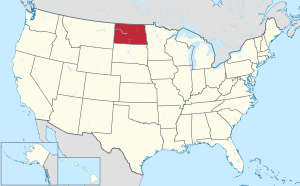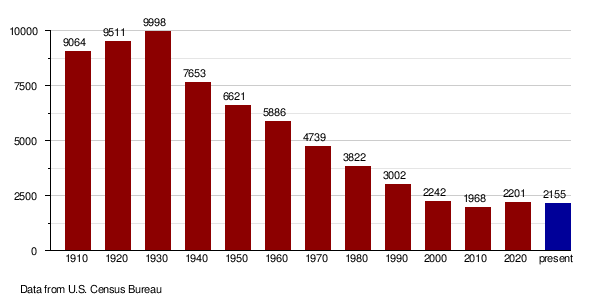County in North Dakota
| Burke County | |
|---|---|
| County | |
 Union Bank of Portal Union Bank of Portal | |
 Location within the U.S. state of North Dakota Location within the U.S. state of North Dakota | |
 North Dakota's location within the U.S. North Dakota's location within the U.S. | |
| Coordinates: 48°47′N 102°31′W / 48.79°N 102.52°W / 48.79; -102.52 | |
| Country | |
| State | |
| Founded | 1910 |
| Named for | John Burke |
| Seat | Bowbells |
| Largest city | Powers Lake |
| Area | |
| • Total | 1,129 sq mi (2,920 km) |
| • Land | 1,104 sq mi (2,860 km) |
| • Water | 25 sq mi (60 km) 2.2% |
| Population | |
| • Total | 2,201 |
| • Estimate | 2,155 |
| • Density | 1.9/sq mi (0.75/km) |
| Time zone | UTC−6 (Central) |
| • Summer (DST) | UTC−5 (CDT) |
| Congressional district | At-large |
| Website | www |
Burke County is a county on the north edge of the U.S. state of North Dakota, adjacent to the south line of Canada. As of the 2020 census, the population was 2,201. The county seat is Bowbells. The county is named after John Burke, the tenth Governor of North Dakota.
History
A vote was held on November 3, 1908, in which county voters authorized the partition of Burke County from what was then known as 'Imperial Ward County' (which consisted of what is now Burke, Mountrail, Renville, and Ward counties). Its name recognized the state governor at the time, John Burke. However, the vote was challenged in court, and appealed to the state supreme court. That court ruled on June 3, 1910, to uphold the election results, so on July 12, Governor Burke issued a proclamation creating Burke County. Its organization was effected on July 15, with Bowbells as its county seat. The county is managed by a three-member Board of Commissioners. As of 2018 the board chair is Debbie Kuryn.
Geography
Burke County lies on the north line of North Dakota. Its north boundary line abuts the south boundary line of Canada. The Des Lacs River flows south-southeasterly through the east part of the county, and the White Earth River flows northeasterly through the lower part. The county terrain consists of semi-arid low hills in the northeast part of the county, with higher carved and eroded ridges on the southwestern portion of the county. The area is partly used for agriculture. The terrain slopes to the north; its highest point is on the lower west boundary line, at 2,461 ft (750 m) ASL. The county has a total area of 1,129 square miles (2,920 km), of which 1,104 square miles (2,860 km) is land and 25 square miles (65 km) (2.2%) is water.
Major highways
 U.S. Highway 52
U.S. Highway 52 North Dakota Highway 5
North Dakota Highway 5 North Dakota Highway 8
North Dakota Highway 8 North Dakota Highway 40
North Dakota Highway 40 North Dakota Highway 50
North Dakota Highway 50
Adjacent counties and rural municipalities
- Estevan No. 5, Saskatchewan – north
- Coalfields No. 4, Saskatchewan – north
- Enniskillen No. 3, Saskatchewan – north
- Renville County – east
- Ward County – southeast
- Mountrail County – south
- Williams County – southwest
- Divide County – west
Protected areas
Lakes
- Beaver Lake
- Enget Lake
- Iverson Slough
- Powers Lake (part)
- Shallow Lake
- Swensons Slouth
- Teal Slough
- Thompson Slough
- Upper Thompson Lake
Demographics
| Census | Pop. | Note | %± |
|---|---|---|---|
| 1910 | 9,064 | — | |
| 1920 | 9,511 | 4.9% | |
| 1930 | 9,998 | 5.1% | |
| 1940 | 7,653 | −23.5% | |
| 1950 | 6,621 | −13.5% | |
| 1960 | 5,886 | −11.1% | |
| 1970 | 4,739 | −19.5% | |
| 1980 | 3,822 | −19.4% | |
| 1990 | 3,002 | −21.5% | |
| 2000 | 2,242 | −25.3% | |
| 2010 | 1,968 | −12.2% | |
| 2020 | 2,201 | 11.8% | |
| 2022 (est.) | 2,155 | −2.1% | |
| U.S. Decennial Census 1790-1960 1900-1990 1990-2000 2010-2020 | |||
2020 census
As of the census of 2020, there were 2,201 people.
2010 census
As of the census of 2010, there were 1,968 people, 913 households, and 567 families in the county. The population density was 1.8 inhabitants per square mile (0.69 inhabitants/km). There were 1,340 housing units at an average density of 1.2 units per square mile (0.46 units/km). The racial makeup of the county was 97.8% white, 0.8% American Indian, 0.7% Asian, 0.2% black or African American, 0.0% from other races, and 0.6% from two or more races. Those of Hispanic or Latino origin made up 1.9% of the population. In terms of ancestry, 45.2% were of Norwegian, 34.9% German, 13% Swedish, and 10% Danish ancestry.
Of the 913 households, 22.6% had children under the age of 18 living with them, 52.4% were married couples living together, 5.4% had a female householder with no husband present, 37.9% were non-families, and 33.6% of all households were made up of individuals. The average household size was 2.15 and the average family size was 2.74. The median age was 48.1 years.
The median income for a household in the county was $50,800 and the median income for a family was $62,283. Males had a median income of $49,958 versus $27,206 for females. The per capita income for the county was $32,347. About 3.3% of families and 5.8% of the population were below the poverty line, including 9.4% of those under age 18 and 6.1% of those age 65 or over.
Population by decade

Economy
The main industries in Burke County are farming and oil extraction. Burke County is one of several western North Dakota counties with significant exposure to the Bakken Formation in the Williston Basin.
Communities
Cities
Census-designated place
Unincorporated communities
- Atcoal
- Battleview
- Coteau
- Kincaid
- Northgate
- Perella
- Rival
- Stampede
- Woburn
Townships
- Battleview
- Bowbells
- Carter
- Clayton
- Cleary
- Colville
- Dale
- Dimond
- Fay
- Foothills
- Forthun
- Garness
- Harmonious
- Kandiyohi
- Keller
- Lakeview
- Leaf Mountain
- Lucy
- Minnesota
- North Star
- Portal
- Richland
- Roseland
- Short Creek
- Soo
- Thorson
- Vale
- Vanville
- Ward
Politics
Burke County voters have been reliably Republican for several decades. In no national election since 1964 has the county selected the Democratic Party candidate (as of 2024). In 1912, it was one of only four counties nationwide to vote for Socialist nominee Eugene Debs.
| Year | Republican | Democratic | Third party(ies) | |||
|---|---|---|---|---|---|---|
| No. | % | No. | % | No. | % | |
| 2024 | 909 | 86.08% | 130 | 12.31% | 17 | 1.61% |
| 2020 | 994 | 86.06% | 137 | 11.86% | 24 | 2.08% |
| 2016 | 895 | 85.08% | 119 | 11.31% | 38 | 3.61% |
| 2012 | 769 | 75.17% | 230 | 22.48% | 24 | 2.35% |
| 2008 | 640 | 67.87% | 286 | 30.33% | 17 | 1.80% |
| 2004 | 808 | 69.36% | 336 | 28.84% | 21 | 1.80% |
| 2000 | 698 | 67.18% | 296 | 28.49% | 45 | 4.33% |
| 1996 | 483 | 44.35% | 416 | 38.20% | 190 | 17.45% |
| 1992 | 551 | 36.15% | 458 | 30.05% | 515 | 33.79% |
| 1988 | 971 | 57.46% | 693 | 41.01% | 26 | 1.54% |
| 1984 | 1,298 | 69.45% | 543 | 29.05% | 28 | 1.50% |
| 1980 | 1,442 | 73.27% | 418 | 21.24% | 108 | 5.49% |
| 1976 | 1,087 | 52.03% | 899 | 43.03% | 103 | 4.93% |
| 1972 | 1,446 | 66.36% | 651 | 29.88% | 82 | 3.76% |
| 1968 | 1,239 | 56.83% | 808 | 37.06% | 133 | 6.10% |
| 1964 | 974 | 40.02% | 1,454 | 59.74% | 6 | 0.25% |
| 1960 | 1,609 | 59.88% | 1,076 | 40.04% | 2 | 0.07% |
| 1956 | 1,415 | 59.98% | 936 | 39.68% | 8 | 0.34% |
| 1952 | 1,986 | 69.90% | 811 | 28.55% | 44 | 1.55% |
| 1948 | 1,212 | 50.95% | 972 | 40.86% | 195 | 8.20% |
| 1944 | 1,540 | 54.47% | 1,226 | 43.37% | 61 | 2.16% |
| 1940 | 1,951 | 57.53% | 1,342 | 39.58% | 98 | 2.89% |
| 1936 | 684 | 18.33% | 1,821 | 48.81% | 1,226 | 32.86% |
| 1932 | 906 | 25.21% | 2,473 | 68.81% | 215 | 5.98% |
| 1928 | 2,002 | 58.38% | 1,336 | 38.96% | 91 | 2.65% |
| 1924 | 996 | 39.62% | 135 | 5.37% | 1,383 | 55.01% |
| 1920 | 1,911 | 70.94% | 456 | 16.93% | 327 | 12.14% |
| 1916 | 518 | 31.37% | 922 | 55.84% | 211 | 12.78% |
| 1912 | 264 | 23.57% | 308 | 27.50% | 548 | 48.93% |
See also
References
- ^ "State & County QuickFacts". United States Census Bureau. Retrieved April 6, 2023.
- "Burke County". ND-Direct. Retrieved February 2, 2023.
- Fitzmaurice v. Willis, 127 N.W. 95 (N.D. 1910).
- "Dakota Territory, South Dakota, and North Dakota: Individual County Chronologies". Dakota Territory Atlas of Historical County Boundaries. The Newberry Library. 2006. Archived from the original on April 2, 2018. Retrieved February 1, 2015.
- "County History". North Dakota.gov. The State of North Dakota. Archived from the original on February 2, 2015. Retrieved February 1, 2015.
- "Burke County, ND". Burke County North Dakota. Retrieved February 2, 2023.
- ^ Burke County ND Google Maps (accessed February 15, 2019)
- ""Find an Altitude/Burke County ND" Google Maps (accessed February 15, 2019)". Archived from the original on May 21, 2019. Retrieved February 16, 2019.
- "2010 Census Gazetteer Files". United States Census Bureau. August 22, 2012. Archived from the original on January 29, 2015. Retrieved January 27, 2015.
- "Annual Estimates of the Resident Population for Counties: April 1, 2020 to July 1, 2022". Census.gov. Retrieved April 6, 2023.
- "U.S. Decennial Census". United States Census Bureau. Retrieved January 27, 2015.
- "Historical Census Browser". University of Virginia Library. Retrieved January 27, 2015.
- Forstall, Richard L., ed. (March 27, 1995). "Population of Counties by Decennial Census: 1900 to 1990". United States Census Bureau. Retrieved January 27, 2015.
- "Census 2000 PHC-T-4. Ranking Tables for Counties: 1990 and 2000" (PDF). United States Census Bureau. April 2, 2001. Archived (PDF) from the original on March 27, 2010. Retrieved January 27, 2015.
- Leip, David. "Atlas of US Presidential Elections". uselectionatlas.org. Retrieved April 12, 2018.
| Places adjacent to Burke County, North Dakota | ||||||||||||||||
|---|---|---|---|---|---|---|---|---|---|---|---|---|---|---|---|---|
| ||||||||||||||||
| Municipalities and communities of Burke County, North Dakota, United States | ||
|---|---|---|
| County seat: Bowbells | ||
| Cities |  | |
| Townships | ||
| Unorganized territory | ||
| CDP | ||
| Other communities | ||
| Indian reservation | ||
| Footnotes | ‡This populated place also has portions in an adjacent county or counties | |
48°47′N 102°31′W / 48.79°N 102.52°W / 48.79; -102.52
Categories: